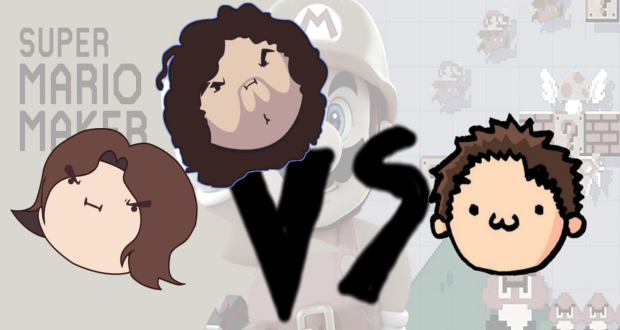Super Mario Maker was released just a few months ago, and the platform creator revolving around the world’s most famous plumber has easily shown up on many console Let’s Player’s videos. And for good reason: the game allows you to share your levels with players all over the world. These levels vary from AutoMarios to fair “that could be in an actual Mario game” to a rage inducing amount of impossible, with some players seeking out levels that have a .01% Completion Percentage.
Among these Let’s Players is Game Grumps, where we have the duo of Arin Hanson and Dan Avidan taking on Mario Maker levels made by their sadistic friends (Ross and ProJared), to more fair levels by IGA. These levels are polar opposites, and this made me think: is there a cultural difference when it comes to Japanese and American Mario Maker Levels? In order to solve this, I had to spend hours watching Japanese Let’s Players and American Let’s Players as they tackled the levels.
I was reminded of The Simpsons episode when the family gets stuck in Japan, and have to enter a game show to make enough money to go back home. The host of the game show says, “In America, you reward knowledge. In Japan, we punish ignorance.” This was the hypothesis I worked with while searching the vast expanse of Youtube.
And what did I find?
In fact, there’s very, very little difference. I compared a Japanese Channel (Abu) to Game Grumps, and after watching roughly 20 hours or so of footage, I thought I’d share some of the similarities that apparently break the language barrier.
Both Game Grumps and Abu’s levels have random Mario Maker levels alongside friend-made Mario Maker Levels. In Abu’s one series (known as Retort vs. Abu) Abu and Retort (on a separate channel) take turns making hard levels for one another. Then they will show off their level, making it look easy before releasing the level upon the masses. This show of talent and dedication is immediately followed (or preceded) by the attempt of their friend’s level. As I only watched Abu play Retort’s levels, I only saw Abu’s reactions.
Game Grumps, on the other hand, plays a handful of levels made by their friends, fans, or well-known people. We don’t see their friends play levels, nor do we see the Game Grumps make any levels. Instead, we see their raw reaction to the level as they play them multiple times.
By coincidence, both of the levels these channels play have low completion rates, with one of the levels Abu plays having a 0.01% completion rate, however unlike the levels we see Game Grumps play with low completion rates, Abu and Retort’s levels have a lot fewer overall plays. On the few times Abu does die, we see the X’s that appear to be minimal, while Game Grumps’ tend to die among a field of X’s.
Ignoring the comparative popularity of both channels however, another difference stuck out to me as I watched Abu traverse the levels. These levels were by no means easy; they were full of pit traps, jump blocks, and inconvenient spikes. Some levels (mostly Abu’s) required the use of the ‘Companion Cube‘-esque strategy of taking a springboard through the pipes to different parts of the level in order to successfully move on. This is mirrored in Ross’s level ‘Companion Spring’; but unlike Ross’s level, Abu’s isn’t sadistic.
The level is meant to be hard, taxing, and challenging. It isn’t a walk in the park, and one wrong jump could derail the whole level. But the level does not punish the player in quite the same way. Ross’s level ‘Companion Spring’ makes you take the spring across many many parts of the level, while Abu’s, by comparison, is much shorter and straight-forward. Ross’s levels also tend to have bosses on top of bosses to the point they become nonsensical totem poles of pain; no such element is found in Abu’s levels. Boss characters exist, but not stacked, making the levels appear much more genuine and less abusive.
Maybe a sign of cultural difference, or perhaps simply personality difference, Abu’s runs of levels are much slower overall. While Arin tends to just try to get through parts as fast possible out of pure frustration, Abu’s approach is a lot slower, almost calculating. Abu does die, on occasion, but his deaths don’t end to the controller breaking frustration that Arin has. Nor do we, the viewers, ever see Abu rage quit, and his videos continue to be made, unlike Game Grumps, who have lulls in their Super Mario Maker productions due to the stress it causes them.
I also originally thought, going into watching Abu’s videos, that I would end up being dazed and confused with not knowing Japanese. I then found out that this wasn’t the case; even with the small amounts of anime based Japanese I knew, I could follow his commentary with relative contextual ease.
Of course, I can’t tell you what he said word-for-word, but I CAN tell you his scream when falling into a pit or dying is just as shrill as Arin’s when the same happens. And in the end, the emotional reaction is what we need when we watch a Let’s Play of a game – like watching NASCAR we only watch it for the crashes and mistakes, and in any language, these things shine through.
(I’d also like to thank the great translators and friends over at GingaScans.com who helped me in my Let’s Player research, as their knowledge of Japanese was a lot more expansive than my own, and without them, this article would not be possible.)


